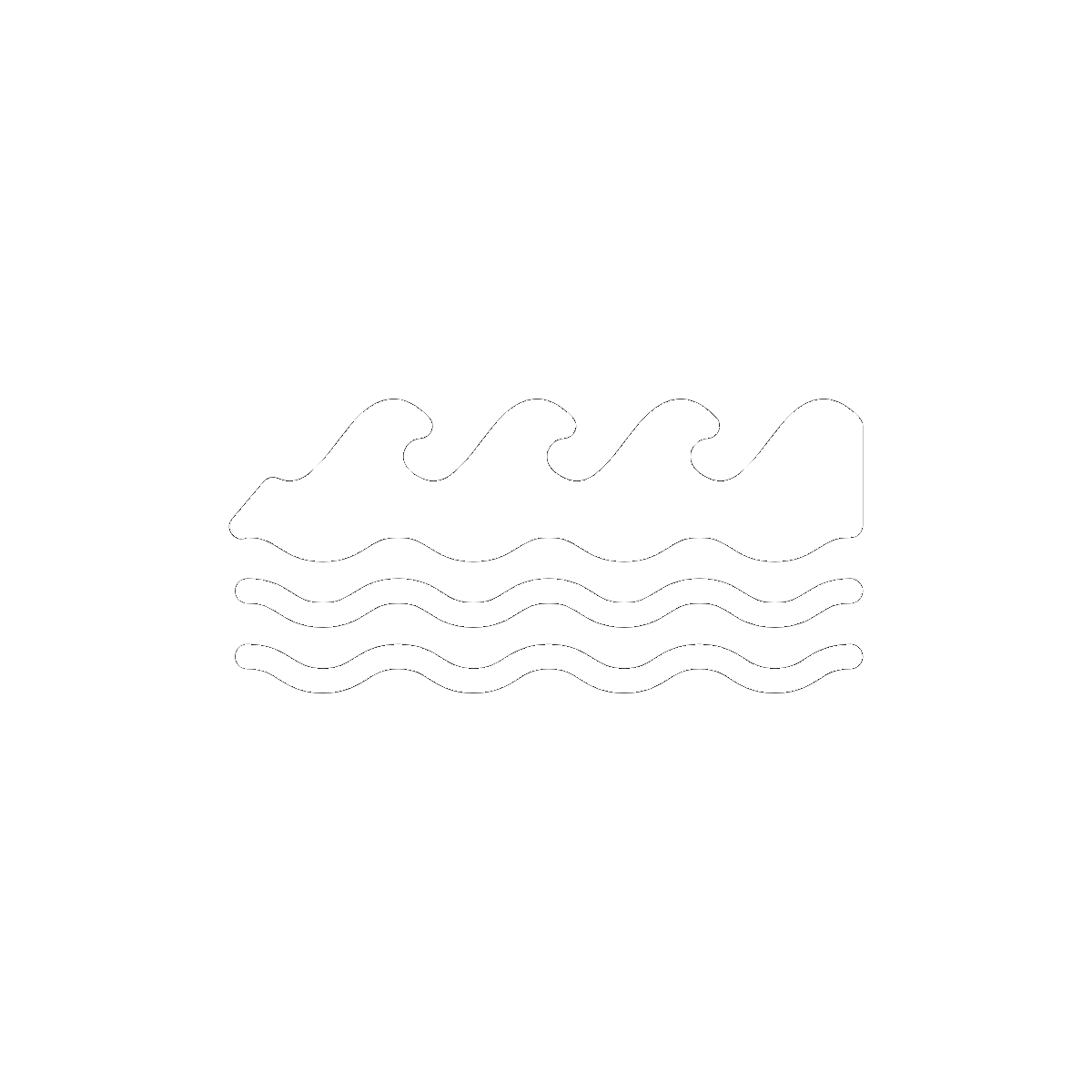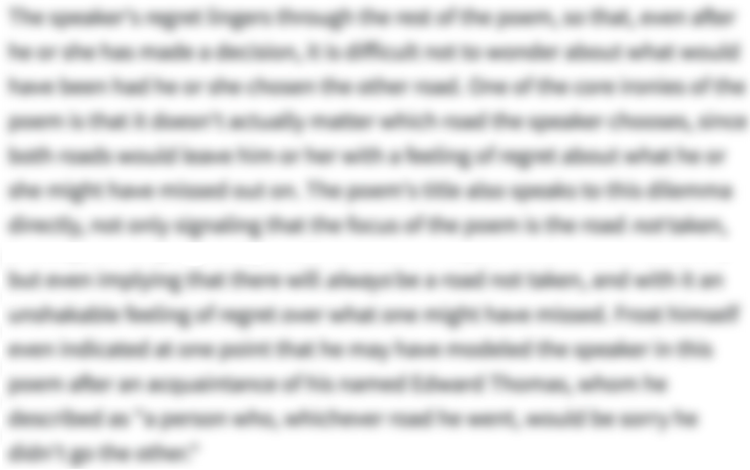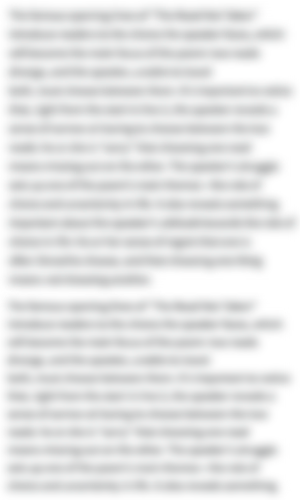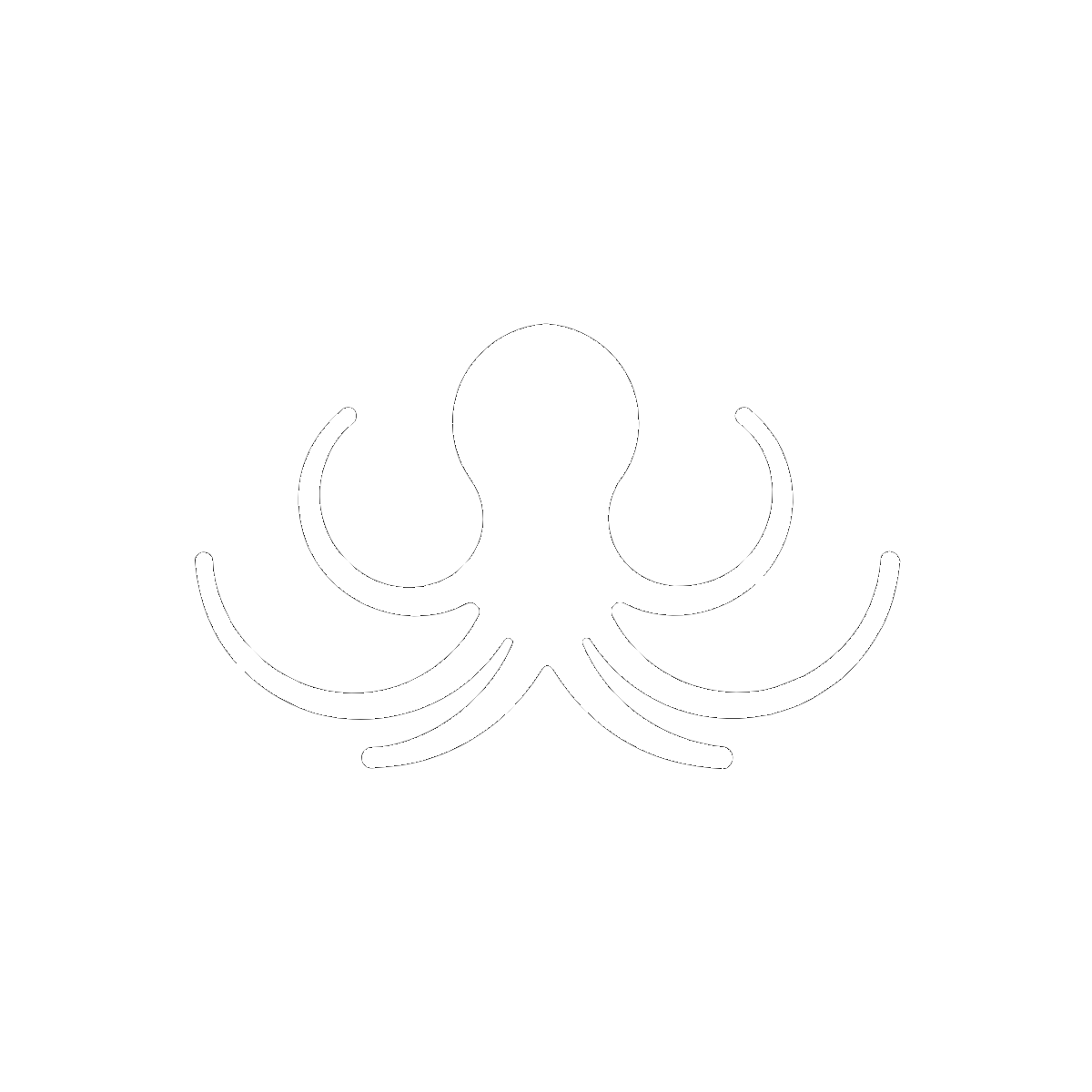The Full Text of “The Kraken”
1Below the thunders of the upper deep,
2Far, far beneath in the abysmal sea,
3His ancient, dreamless, uninvaded sleep
4The Kraken sleepeth: faintest sunlights flee
5About his shadowy sides; above him swell
6Huge sponges of millennial growth and height;
7And far away into the sickly light,
8From many a wondrous grot and secret cell
9Unnumbered and enormous polypi
10Winnow with giant arms the slumbering green.
11There hath he lain for ages, and will lie
12Battening upon huge sea worms in his sleep,
13Until the latter fire shall heat the deep;
14Then once by man and angels to be seen,
15In roaring he shall rise and on the surface die.
-
“The Kraken” Introduction
-
Alfred, Lord Tennyson published "The Kraken" in 1830 in Poems, Chiefly Lyrical. A sonnet with an extra line, the poem is about the mythical sea monster known as the "Kraken," a legendary beast that has haunted old sailor stories, folklore, and literature since the 13th century. An enormous squid-like creature, the Kraken is supposedly capable of dragging entire ships down to its dwelling place in the deepest reaches of the ocean. In the poem, though, the Kraken simply sleeps an ancient slumber in the depths, where—the speaker implies—it will remain until a religious reckoning drives it to the surface to die.
-
-
“The Kraken” Summary
-
The poem opens with a description of a place that is even lower than the powerful waters of the ocean's initial depths, a place deep in the terrible abyss of the sea. It is in these depths that, without dreams or interruption, the Kraken slumbers in his long sleep. Dim rays of sun barely reach this far down in the ocean, where they fail to illuminate the Kraken's dark shape. In the waters above the monster there are large sea sponges that have been growing for thousands of years. And far from the Kraken's body in the ocean's weak light, emerging from multiple little caves, many giant jellyfish-like creatures churn the water with their large tentacles. The Kraken has remained in the depths of the ocean for a very long time and will continue to inhabit the deep, sustaining himself by eating large eels while sleeping—until, that is, the world is consumed by fire and even the lowest points of the ocean begin to heat, at which point humans and angels will finally catch a single glimpse of the Kraken as he raucously rises to the surface of the ocean to die.
-
-
“The Kraken” Themes
-

The Eeriness of the Unknown
“The Kraken” explores the unsettling nature of the unknown. Describing the depths of the ocean, the poem presents an otherworldly setting that not only seems foreign and strange, but also untouched by humankind. As if this remote setting weren’t enough to make readers feel estranged from their own world, the poem primarily focuses on the Kraken, a mythological sea monster shrouded in mystery and fear. The idea of the Kraken lurking in the deepest reaches of the ocean adds to the eeriness of the poem, underscoring just how disquieting it can be to contemplate the unknown.
Before the poem even introduces the Kraken, it demonstrates that some parts of the world are largely unfamiliar to human beings. The first line suggests that the poem is set beyond the “upper deep” of the ocean, thereby implying that there are depths even lower than what people normally think of when they hear the word “deep.” Playing on this notion, these seemingly bottomless parts of the ocean are referred to as “abysmal,” a word that denotes extreme depth but also describes something terrible or appalling. In turn, the world of the deep sea takes on a frightening, foreboding aspect, and this helps establish the remote setting of the Kraken’s home as a mysterious, chilling place.
It is in this otherworldly context that the Kraken dwells in an “uninvaded sleep,” completely uninfluenced by the outside world. Given that the Kraken is a sea monster that often appears in ancient folklore, the sense of mystery surrounding the mythical beast is quite strong, and the poem emphasizes the monster’s ominous qualities by describing it in vivid terms. Indeed, the Kraken is presented in the poem as a giant creature who has “shadowy sides” and eats “enormous” squid-like animals as they sweep through the dark waters of the abyss. As such, it becomes clear that the Kraken not only exists in a context unknown to humans, but is itself a ghastly, uncanny being.
At the same time, though, it’s worth noting that the only thing the Kraken actually does in this poem is sleep and eat “sea worms.” In truth, there is nothing inherently terrifying about either of these actions. And yet, the Kraken still seems like a terrifying creature because it exists out of sight, dwelling in the farthest depths of the ocean. In keeping with this, there is something ominous about the idea of an enigmatic creature lurking in a dark, unfamiliar location that remains untouched my humankind. It is this very lack of familiarity, then, that makes the Kraken so frightening, ultimately suggesting that humans are easily unsettled by the unknown.
- See where this theme is active in the poem.
-

History and End Times
As a poem, “The Kraken” isn’t just interested in mining the depths of the ocean, but of history, too. This is made evident by the fact that the Kraken itself is an ancient creature, one that has figured prominently into legends and myths for hundreds of years. In keeping with this, the poem depicts the Kraken as something that has seemingly always been in existence—something as old and elemental as the earth itself.
In this way, the Kraken is a constant (albeit unseen and ominous) presence in the world, and the only thing that will end its time on earth is—apparently—some kind of Biblical reckoning that will finally drive the monster to the surface of the ocean. Under this interpretation, the Kraken’s death will coincide with the end of the world as humanity knows it. Accordingly, it becomes clear that even the most ancient and enduring creatures will not survive in this world forever.
The language used in reference to the Kraken alerts readers to the rich history of the monster’s existence. The speaker describes the creature as sleeping an “ancient, dreamless” sleep, one that has gone uninterrupted for a very long time. In fact, the Kraken is so old that the sea sponges around it have grown to “millennial” heights, meaning that they’ve been growing for thousands of years. What’s more, the poem suggests that the Kraken has “lain for ages” in the dark reaches of the ocean, sleeping all the while. That the monster is asleep is particularly noteworthy, as it depicts the Kraken’s resting state as consistent and unchanging. In turn, the sea monster comes to represent a certain constancy in the world, even if its presence is also frightening and dangerous.
However, the last three lines of the poem uphold that there will come a day when the Kraken’s steady slumber will end. Indeed, the speaker says the Kraken will continue to sleep “until the latter fire shall heat the deep.” The image of fire consuming the seas suggests that there will be some kind of reckoning—perhaps religious, perhaps political—that will fundamentally change the world.
Having said that, though, the poem doesn’t provide quite enough information to fully contextualize or interpret this line as a reference to any specific religious or political belief. The only thing readers know for sure is that an event with religious overtones will take place and that it will be significant enough to not only drive the Kraken from the depths of the sea, but also kill the creature once it reaches the surface. In this way, the poem implies that, just as the ancient Kraken will eventually die, so too will the world as we know it someday come to an end.
- See where this theme is active in the poem.
-
-
Line-by-Line Explanation & Analysis of “The Kraken”
-
Lines 1-2
Below the thunders of the upper deep,
Far, far beneath in the abysmal sea,These first two lines establish the setting of the poem, describing an extraordinarily deep part of the ocean. The reference to the "upper deep" in line 1 is especially important because it suggests that there are varying degrees of depth in the ocean itself. In other words, it's not enough to say that the ocean is simply "deep." As such, the speaker makes a distinction between the "upper deep" and areas that are even farther down. To that end, the "upper deep" is most likely what comes to mind for most people when they think about the immediate depths of the ocean, which is the oceanic layer in which the most familiar marine animals live.
"The Kraken," however, takes place below these somewhat familiar depths, plunging deep into the "abysmal sea." The word "abysmal" is particularly noteworthy, since it can either mean terrible and appalling or extraordinarily deep. Indeed, the word derives from the "abyss," which refers to endless, void-like chasms. Because "abysmal" can be interpreted both ways, then, the word not only helps the speaker describe just how deep these waters are, but also allows the speaker to associate these depths with an ominous, foreboding quality. In this way, readers feel as though they are being drawn down into an unsettling and remote place, sinking past the familiar and into the unknown.
There is also a muscular sound to these opening lines, which are subtly consonant. For instance, the /b/, /p/, and /r/ sounds work their way throughout both lines:
Below the thunders of the upper deep,
Far, far beneath in the abysmal seaNone of these instances of consonance jump out at readers right away, but their presence in these lines is prominently felt, giving the entire opening a strong sound that aligns with the imagery of the thunderous ocean waters. In this sense, the consonance emboldens the beginning of the poem, giving it a power reminiscent of the low rushing sound that would accompany the act of plunging into the "abysmal sea."
-
Lines 3-5
His ancient, dreamless, uninvaded sleep
The Kraken sleepeth: faintest sunlights flee
About his shadowy sides;

Unlock all 462 words of this analysis of Lines 3-5 of “The Kraken,” and get the Line-by-Line Analysis for every poem we cover.
Plus so much more...
Get LitCharts A+ -
Lines 5-6
above him swell
Huge sponges of millennial growth and height; -
Lines 7-10
And far away into the sickly light,
From many a wondrous grot and secret cell
Unnumbered and enormous polypi
Winnow with giant arms the slumbering green. -
Lines 11-12
There hath he lain for ages, and will lie
Battening upon huge sea worms in his sleep, -
Lines 13-15
Until the latter fire shall heat the deep;
Then once by man and angels to be seen,
In roaring he shall rise and on the surface die.
-
-
“The Kraken” Symbols
-

The Kraken
Because it is a monster with seemingly no contact with the outside world, the Kraken is a perfect embodiment of the unknown. This poem doesn't actually describe the creature itself all that much, and instead focuses on the creature's remote life in the darkest, deepest reaches of the ocean. In fact, the speaker's refusal to describe the Kraken in a concrete way actually makes the monster seem even more unsettling, casting it as an ominous figure that readers can't even fully grasp.
To that end, the only mention of the Kraken's physical form is a fleeting reference to its "shadowy sides." This, in turn, means that readers must struggle to build their own image of the Kraken, and this element of mystery only emphasizes the monster's existence as an ominous, unknown figure. Accordingly, the Kraken itself comes to represent what it feels like to confront the unfamiliar.
At the same time, the Kraken has been written about time and again over the centuries, and has a reputation as a dangerous and violent beast. That violence isn't really present in this poem, but different readers have also taken the creature as representative of human darkness buried so deeply that it feels foreign and alien.
- See where this symbol appears in the poem.
-
-
“The Kraken” Poetic Devices & Figurative Language
-
Assonance
Assonance appears in "The Kraken" most strongly in the opening quatrain, which repeats the /ee/ sound quite prominently. This long /ee/ sound is particularly noticeable because it appears in the final word of every line in the quatrain, as well as in other words throughout the lines:
Below the thunders of the upper deep,
Far, far beneath in the abysmal sea,
His ancient, dreamless, uninvaded sleep
The Kraken sleepeth: faintest sunlights fleeThe /ee/ sound threaded throughout these lines creates several internal slant rhymes, as is the case in line two with the words "beneath" and "sea." This, in turn, gives the entire opening a feeling of unification and musicality that oddly contrasts with the otherwise gloomy and ominous subject. In this regard, the poem's heightened language and euphonic sound juxtapose its dark, sinister qualities.
Indeed, it is perhaps because of these sinister qualities that the pleasing assonance found in the first quatrain completely drops off in the second quatrain, as the speaker begins to focus more intensely on the Kraken's chilling environment. Indeed, as the speaker describes the Kraken's surroundings, the overall musical quality shifts considerably, veering away from assonance (apart from that seen in a few more end rhymes) and toward consonance.
This, of course, is not to say that the speaker's use of consonance isn't also musical, but this kind of musicality is much more muscular and contoured, whereas the assonance in the beginning of the poem is more relaxed. However, assonance eventually returns in line 10, bringing back the repeated long /ee/ sound that characterizes the first four lines of the poem. In this way, the sound of the poem comes full circle, ultimately developing a consistent sound that one might argue reflects the Kraken's ancient, unchanging state of rest.
- See where this poetic device appears in the poem.
-
Caesura


Unlock all 257 words of this analysis of Caesura in “The Kraken,” and get the poetic device analyses for every poem we cover.
Plus so much more...
Get LitCharts A+ -
Consonance
-
End-Stopped Line
-
Repetition
-
Sibilance
-
Imagery
-
-
“The Kraken” Vocabulary
Select any word below to get its definition in the context of the poem. The words are listed in the order in which they appear in the poem.
- Upper Deep
- Abysmal
- Uninvaded
- Sponges
- Millennial
- Sickly
- Grot
- Secret Cell
- Polypi
- Winnow
- Battening
- Latter Fire
Upper Deep-
In this context, the phrase "upper deep" refers to a layer of the ocean that, although still quite deep, is near the water's surface. By using the word "upper," the speaker implies that there are varying levels of what might be considered "deep." This, in turn, alerts readers to the fact that the poem takes place in an especially deep part of the ocean.
- See where this vocabulary word appears in the poem.
-
Form, Meter, & Rhyme Scheme of “The Kraken”
-
Form
The poem functions as a sonnet even though it has an extra line. Like most sonnets, it follows a set rhyme scheme, is composed in iambic pentameter (meaning that most lines contain five iambs, or da-DUMs), and even features a turn near the end of the poem when the speaker notes that the Kraken will someday be roused from his ancient slumber.
However, there is no denying that there are 15 lines instead of the sonnet's standard 14, a fact that underscores the poem's unwieldiness when it comes to formal structure. After all, the poem doesn't perfectly adhere to any strict sonnet conventions, as made evident not only by its extra line, but also by the fact that the stanza structure isn't neatly organized like it is in most sonnets.
To that end, it's worth noting that the lines of "The Kraken" flow into each other in unconventional ways, streaming from one quatrain to the next. Of course, the first quatrain is almost self-contained, in that the poem's first sentence seems to come to a conclusion halfway through the fourth line, culminating in the caesura after the word "sleepeth." And yet, a new phrase begins in the second half of the fourth line, and this phrase continues into the second quatrain. This is significant because the end of a quatrain is often end-stopped, whereas the end of this poem's first quatrain is enjambed.
This kind of unexpected continuation from one quatrain to the next is even more apparent in line 8, since almost all sonnets feature end-stopped lines at the end of the first octave (eight lines). In "The Kraken," however, the last line of the octave leads into the first line of the next section—a section that is difficult to label because of the poem's extra line. Indeed, lines 9 through 15 of the poem could either be seen as aligning with the conventions of the Italian sonnet or with those of the Elizabethan sonnet.
If the remaining lines are based on the Italian sonnet, then they constitute a sestet (six-line stanza) plus an extra line. If, however, they are based on the Elizabethan sonnet, then they form a third quatrain followed by a concluding couplet. Although both interpretations are valid, it seems logical to think of the end of the poem in terms of the Elizabethan sonnet, if only because line 13 (the final line of what could be considered the third quatrain) is end-stopped, meaning that the final couplet is self-contained.
Regardless of how readers decide to conceptualize the poem's form, though, what's most important to grasp is that the lines actively resist neat categorization. Even though "The Kraken" is recognizable as a sonnet, then, it is also large and uncontainable, thereby reflecting the massive and uncanny power of the Kraken itself.
-
Meter
"The Kraken" is written mostly in iambic pentameter, which means that there are five iambs, poetic feet with a "da-DUM" rhythm, per line. For example, the first line scans like this:
Below | the thun- | ders of | the up- | per deep,
It's clear that this line is in iambic pentameter, since each foot is an iamb and the entire line contains five metrical feet. Other lines in the poem, however, are considerably more complicated, making use of a number of metrical substitutions instead of using only iambs. This is especially the case in lines 5 and 6, which are still examples of pentameter (in that there are five feet per line) but feature several deviations from the previously established iambic rhythm:
About | his shad- | owy sides; || above | him swell
Huge spong- | es of | millen- | nial growth | and height;For the most part, line 5 isn't all that different from the other lines, since it is still mostly composed of iambs. However, its third foot is an anapest ("-owy sides"), meaning that it is made up of two unstressed syllables followed by a stressed syllable (da-da-DUM). Building on this sense of variation, line 6 completely deviates from the poem's overall rhythm by beginning with a spondee ("Huge spong-"), which is a somewhat less common metrical foot consisting of two stressed syllables in a row (stressed-stressed).
To add to this, the line's second foot is a pyrrhic ("-es of"), another somewhat uncommon metrical unit made up of two unstressed syllables in a row (unstressed-unstressed). And, lastly—in terms of metrical substitutions—the line's fourth foot is yet another anapest ("-nial growth"). Consequently, it's evident that this line stands out as extraordinary in a poem that is otherwise characterized by a more or less steady adherence to iambic pentameter. And yet, it's also worth noting that lines 5 and 6 are still written in pentameter, since there are only five stresses per line, even if some of those stresses appear in unexpected places.
On the whole, this use of meter ultimately disrupts the otherwise smooth flow of the poem, drawing attention to the irregularities that arise in the verse. And though the majority of the poem is composed in straightforward iambic pentameter, the kinds of variations that appear in lines 5 and 6 also crop up in other places, like in line 12, which also uses an anapest ("-ing upon"), a spondee ("huge sea"), and a pyrrhic ("worms in") to create a somewhat disjointed rhythm. In turn, the speaker's use of metrical substitutions takes the familiarity of iambic pentameter and makes it feel foreign and strange, effectively aligning with the fact that the Kraken itself represents the disconcerting unknown.
-
Rhyme Scheme
The poem follows a set rhyme scheme, but this scheme doesn't align with the way sonnets traditionally rhyme. This is partially due to the fact that "The Kraken" has an extra line, which disorders the rhymes in the latter half of the poem. For instance, whereas the six-line sestet in the traditional Elizabethan sonnet usually concludes with a rhyming couplet, the last two lines of "The Kraken" don't rhyme with each other. Instead, the last line rhymes with the 11th line, functioning more as a distant echo than as a prominent rhyme.
This, however, is not to say that the poem is completely unorganized when it comes to rhyming. To the contrary, "The Kraken" has a clear—albeit unique—rhyme scheme, which looks like this (note that the stanza divisions here are somewhat arbitrary, since the poem's structure is slightly amorphous):
ABAB CDDC EFEA AFE
As this illustrates, there is a dependable rhyme scheme in the first two quatrains of the poem, both of which follow a fairly standard format. After this eight-line octave, though, the rhyme scheme becomes considerably more irregular, since the rhyme introduced in line 10 ("green") doesn't come to full fruition until the poem's second-to-last line ("seen").
In this way, the speaker delays the rhymes as the poem progresses, especially when it comes to the last line ("die"), which doesn't rhyme with anything except the ninth and eleventh lines—both of which are a bit too far away to create a strong sense of pattern within the rhyme scheme. In the same way that the form of "The Kraken" deviates from the standard structure of a sonnet, then, the rhyme scheme becomes increasingly disorganized in the final lines of the poem. In turn, the poem develops a feeling of unwieldiness, one that perhaps embodies the large and unmanageable form of the Kraken itself.
-
-
“The Kraken” Speaker
-
There is no identifying information about the speaker, who doesn't factor very heavily into the poem. Instead of emerging as a character of some kind, the speaker functions as an omniscient narrator who simply delivers details about the Kraken and its home in the depths of the ocean. In this way, the speaker has a neutral, unnoticeable presence, one that doesn't bring itself to bear on the observations or assertions that run throughout the lines.
Accordingly, some readers may choose to think of the speaker as Tennyson himself, though there's nothing in the poem to either support or debunk this interpretation. Either way, what remains clear is that the speaker is not only capable of vividly describing the oceanic world of the Kraken, but also capable of looking into the future and predicting that the Kraken will one day be driven by fire to the surface of the ocean, where it will finally die. With this in mind, the speaker's omniscient capacities become even more remarkable, ultimately framing the speaker as an all-knowing figure.
-
-
“The Kraken” Setting
-
The poem is set in the deepest parts of the ocean, where the Kraken has been sleeping for years and years. However, the poem never clarifies which ocean the Kraken lives in, instead simply focusing on portraying the environment as extremely remote and untouched by human activity. To that end, the poem meticulously describes the Kraken's surroundings, depicting this part of the ocean as dark and teeming with extraordinarily large creatures like sea sponges that have been growing for thousands of years. And although ancient lore about the Kraken typically suggests that the monster lives in the waters off the coast of Norway, this poem is uninterested in the monster's specific geographical setting, choosing instead to concentrate on detailing the mysterious world of the deep unknown.
-
-
Literary and Historical Context of “The Kraken”
Literary Context
A poem that takes place in the ocean, "The Kraken" is part of a long literary tradition that centers around the power and mystery of the sea. This is a common interest that runs throughout some of Tennyson's most famous poems, which often make use of water-related imagery and use the ocean as either a backdrop or a metaphor. Indeed, poems like "Crossing the Bar," "Ulysses," and "Break, Break, Break" all use the ocean as an important setting or motif.
In general, literature—especially poetry—has celebrated and considered the sea for a very long time. Indeed, Homer's The Odyssey features a long ocean passage and is perhaps the most iconic sea-related story of all time. As for seafaring tales written closer to Tennyson's lifetime, though, Samuel Taylor Coleridge's "The Rime of the Ancient Mariner" was published in 1798 and tells the story of an old sailor who kills an albatross while on a long ocean voyage, bringing bad luck to the entire ship. This story is particularly relevant to "The Kraken" because it spotlights the sailing community's fixation with folklore and superstition, both of which factor heavily into "The Kraken" and its focus on a mythical sea monster.
To that end, Herman Melville's famous novel Moby-Dick also exhibits an interest in what lurks beneath the surface of the ocean—an interest that is clearly on full display in "The Kraken," too. In fact, Moby-Dick even includes mention of a giant Kraken-like creature capable of dragging entire whaling ships to the bottom of the ocean. In this capacity, the novel—which was published roughly 20 years after "The Kraken"—helped keep the myth of the Kraken alive in the world of maritime literature, ultimately serving as a precursor to the mention of an enormous squid in Jules Verne's popular novel Twenty Thousand Leagues Under the Sea, which was published in 1870.
Historical Context
The Kraken has existed as a figure in maritime folklore since at least the 13th century, appearing in old Norse tales about fishermen encountering an enormous sea beast with many tentacles. Later, in the 18th century, the Kraken saw its first mention by name in a well-known natural history book, Systema Nature. Since then, it has been a popular staple in many stories about ocean passages and deep-sea encounters with the unknown.
Interestingly enough, though, "The Kraken" is as much about the monster's surrounding environment as it is about the creature itself. In fact, the speaker spends a large amount of the poem describing the underwater world of the deep sea. This aligns with Tennyson's position as a poet working in the early Victorian era, when the literary landscape began to shift away from the Romanticism that dominated the first half of the 19th century.
Indeed, it's worth noting that Tennyson proceeded William Wordsworth as the United Kingdom's Poet Laureate, but he didn't completely leave behind all the defining characteristics of Romanticism. Like Wordsworth and the other Romantic poets, Tennyson was especially attuned to nature, but his interest in the beauty of the natural world was perhaps a bit more complex and imaginative than that of his predecessors.
"The Kraken," therefore, is a perfect example of how Tennyson expanded the Romantic fascination with nature, since it manages to celebrate the natural world while also making that very world seem foreign, strange, and unsettling. In this way, "The Kraken" showcases the gradual but notable ways in which Tennyson helped the literary world transition away from Romanticism without completely leaving behind some of the movement's most important preoccupations.
-
More “The Kraken” Resources
-
External Resources
-
Practice the Poem's Scansion — Practice your scansion (scanning a line of poetry for its meter) and get a feel for the meter of "The Kraken" by using this interactive tool.
-
The Watcher in the Water — Check out this clip from "The Fellowship of the Ring," in which Frodo and the other hobbits encounter a ghastly Kraken-like creature known as the "Watcher in the Water."
-
Twenty Thousand Leagues Under the Sea — For another look at a giant squid-like creature, take a look at this illustration that was published in the original 1870 version of Jules Verne's novel "Twenty Thousand Leagues Under the Sea."
-
Moby-Squid — Read a short chapter from Herman Melville's "Moby-Dick," which mentions a large squid that was based on the legends of the Kraken.
-
Release the Kraken! — Enjoy watching a very shiny Liam Neeson yell "Release the Kraken!" while playing Zeus in the 2010 film "Clash of the Titans."
-
-
LitCharts on Other Poems by Alfred Lord Tennyson
-








